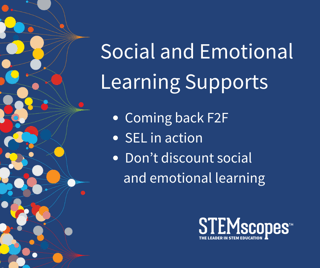
5 Easy Math Engagement Strategies for the Classroom
The news headlines are daunting. Math scores are down. School districts are scrambling to turn things around. And...
Lesly Gregory | Published March 22, 2021
The coronavirus pandemic has changed a lot for students across the country. They’ve spent time learning virtually, worked independently more often, and seen less consistency as they’ve moved in and out of classrooms. While its impact on academics remains a constant conversation, there are other developmental milestones to watch out for as we get closer and closer to normalcy.
 One of the areas to watch involves students’ social and emotional learning (SEL). This is an integral part of education, but also of human development since young people are acquiring and applying the, “knowledge, skills, and attitudes to develop healthy identities, manage emotions and achieve personal and collective goals.” This then helps them both feel and show empathy while becoming better at establishing supportive relationships and making responsible decisions.
One of the areas to watch involves students’ social and emotional learning (SEL). This is an integral part of education, but also of human development since young people are acquiring and applying the, “knowledge, skills, and attitudes to develop healthy identities, manage emotions and achieve personal and collective goals.” This then helps them both feel and show empathy while becoming better at establishing supportive relationships and making responsible decisions.
There are five core components of SEL—self awareness, self management, social awareness, relationship skills, and responsible decision-making—but success is all about implementation, which has become more difficult due to COVID-19. Differing and changing learning environments present challenges for SEL as students lose the ability to engage with each other in person. But, opportunities for face-to-face interaction are picking up, and we’ll need SEL even more now to direct these students toward lifelong success.
As students start returning to school, and face-to-face learning becomes the norm once again, SEL can help reestablish personal connections that may have deteriorated during COVID-19. Utilizing SEL strategies may even help minimize behavioral issues as students readjust to being back in the classroom.
A perfect pandemic response to all the uncertainty students have faced in the last year, SEL practices offer tools for students that can help them cope with stress and anxiety through a focus on self-care and mindful responses.
A complete SEL program has many components, but you don’t have to go big right from the start. Beginning with a small group of teachers first has many benefits since it allows you to shape your program before rolling it out to the entire school. Work with teachers willing to give honest feedback and involve staff at every stage of your implementation so you can constantly assess, and reassess, the effectiveness of your SEL program.
When it comes to SEL, science is a great place to start. The science curriculum easily lends itself to group projects—a perfect problem-solving environment to practice SEL. For example, when students study erosion, an easy group project may address preventing a model town from flooding. Students build the model, then devise a plan on how to stop erosion from “rainfall.” Through trial and error, they test their ideas to find what works best.
Within projects like this, there are certain personalities you’ll often see, including:
This disparity between group members doesn’t have to exist. SEL can help by driving collaboration and providing an opportunity for students to grow their social and emotional skills in a relatively low-stakes environment.
Going back to the erosion example, it has all the components of a perfect SEL opportunity. It requires problem-solving, collaboration, and the testing of ideas. It may help draw students out of their stereotypical role, and encourage them to feel comfortable engaging.
While the erosion project is a great example of an SEL project, the secret is knowing your students. This way, you can anticipate their capabilities and develop activities that best support their needs. You can also infuse projects with opportunities to enhance SEL. This can help drive confidence, especially in a classroom with a combination of high and low performers.
Some great methods to use when crafting activities within your science curriculum include:
Most important, allow for on-the-spot adjustments to any planned project to ensure you’re doing what works for your students. Watch how groups are working, and intervene when you notice a student isn’t participating. It’s also a good idea to end projects with a little time left for all-class reflection. This keeps students engaged in the whole process. They complete the project, but then also get to share with you their favorite part, how they solved problems, or why they worked so well together.
SEL offers a lot of potential for students, but most importantly it helps build their sense of identity and their confidence in themselves as learners. During a period of so much change and uncertainty, of alternate learning methods, and stress, it is essential that we remind students they can overcome by giving them the skills that make that possible. Doing this through well-thought-out group work and projects is the perfect way to acclimatize students to working with others in person once again.
It will take a village to move past COVID-19, but SEL may prove to be one of our strongest resources.
Sources:
https://casel.org/wp-content/uploads/2021/01/11_CASEL-Program-Criteria-Rationale.pdf
https://www.edutopia.org/article/social-and-emotional-learning-science-class
http://www.ascd.org/ascd-express/vol14/num04/Five-Tips-for-Successful-SEL-Implementation.aspx

The news headlines are daunting. Math scores are down. School districts are scrambling to turn things around. And...

Math assessment in California is changing. What used to be a compliance exercise or reporting tool is now becoming a...

You know the moment: a student’s eyes light up when the science experiment fizzes or the math puzzle helps them...